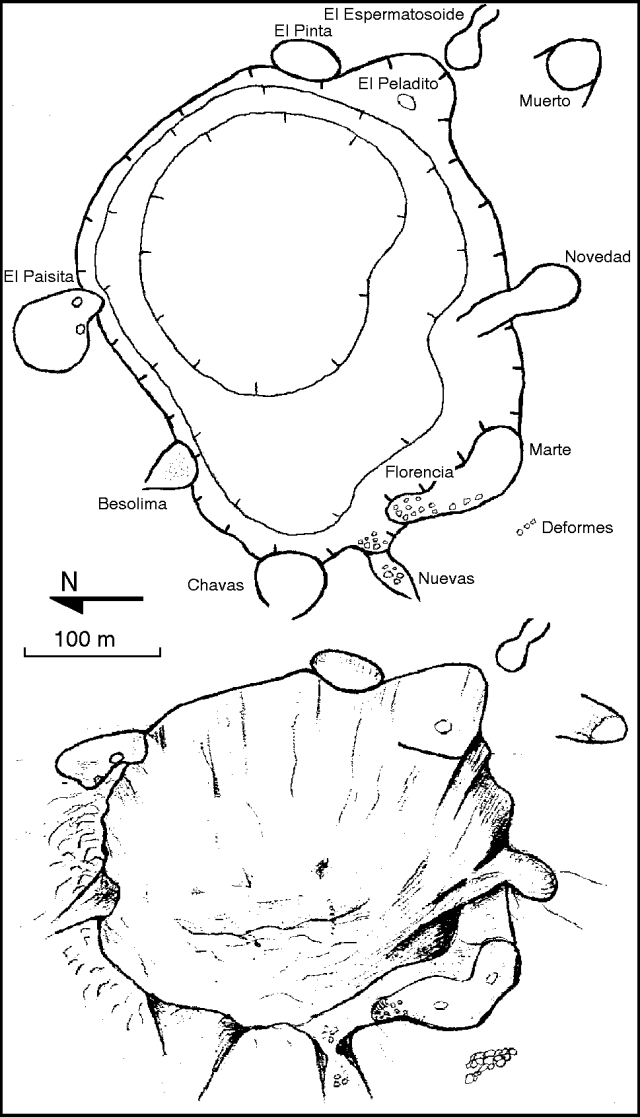Report on Galeras (Colombia) — July 1994
Bulletin of the Global Volcanism Network, vol. 19, no. 7 (July 1994)
Managing Editor: Richard Wunderman.
Galeras (Colombia) Seismicity remains low; crater described and fumarole temperatures reported
Please cite this report as:
Global Volcanism Program, 1994. Report on Galeras (Colombia) (Wunderman, R., ed.). Bulletin of the Global Volcanism Network, 19:7. Smithsonian Institution. https://doi.org/10.5479/si.GVP.BGVN199407-351080
Galeras
Colombia
1.22°N, 77.37°W; summit elev. 4276 m
All times are local (unless otherwise noted)
Seismicity during June and July showed no significant changes. . . . Low-frequency seismicity was at very low levels during June, although a "screw-type" event did occur; this type of event was numerous before eruptions in 1992-93. Shallow "butterfly-type" activity during the first half of June was similar to May, when the number of events decreased notably. These small-amplitude, short-duration, high-frequency events, interpreted as caused by fluid movement or rock fracture at shallow depths (<2 km) near the active cone, increased in number in the second half of June and through July. During June the fracture events were located N of the volcano, near the source that was active during November-December 1993, with other fracture events to the NE or closer to the crater. Additional sources were W and S of the crater. Fracture activity within the crater consisted of very small magnitude events (M <2.3) at depths between 2.1 and 9.7 km.
The active inner cone was visited on 21 July 1994 by volcanologists from INGEOMINAS and the Univ de Montréal. The morphology of the cone was modified considerably by the eruptions of 1992-93, which seem to have progressively deepened the crater to the present level of 200-300 m (figure 71). Prior to dome emplacement during October-November 1991 the crater was ~ 150 m deep; after dome growth in 1991-92, the crater was ~80 m deep. A N-S trending fracture, named Novedad, now breaches the S crater rim. Partial collapse of the crater rim and blocks 10-20 cm in size were noted on the N side of the cone.
Some low-pressure fumaroles were noted in the deepest part of the crater, but gas was being emitted mainly in the shallower W and SW sectors. At Deformes fumarole, on the SW flank of the cone, temperature was measured and gas samples were collected for analysis. Maximum temperature was 138°C, significantly cooler than the ~200°C recorded in December 1992 and January 1993 (Zapata G., 1992; Goff et al., 1993). Besolima, generally the hottest measured fumarole on the cone's outer flanks, had largely disappeared. Las Chavas fumarole showed very low activity with a maximum temperature of 105°C. A new fumarole near the W rim of the cone, named Nuevas, had temperatures of 208 and 392°C. This fumarole is in the area where Florencia fumarole and remnants of the lava dome (destroyed in July 1992) had temperatures of 640°C on 26 November 1992 (Zapata G., 1992).
Stationary COSPEC measurements of SO2 in June from five points around the volcano showed low levels of gases (18-176 t/d), similar to the measurements obtained using the mobile COSPEC (79-217 t/d). July degassing was concentrated on the W periphery of the active cone, with low concentrations of SO2 (<220 t/d) measured by COSPEC.
Electronic tiltmeter variations in June at the Peladitos station were 2.4 µrad in the tangential component and 7.8 µrad in the radial component. The Crater tiltmeter fluctuated in June due to electronic problems; no deformation was observed in July. On 7 July the Agua Tibia springs, located in the Rio Azufral valley 5 km W of the active cone, had a temperature of 21°C and pH of 5.
References. Zapata G., J.A., 1992, Visita al crater del volcan Galeras: INGEOMINAS Internal Report, 30 November 1992, 2 p.
Goff, F., McMurtry, G.M., Adams, A.I., and Roldán-M., A., 1993, Stable isotopes and tritium of magmatic water at Galeras volcano, Colombia: EOS, Trans. Am. Geophys. Union, 74(43), p. 690.
Geological Summary. Galeras, a stratovolcano with a large breached caldera located immediately west of the city of Pasto, is one of Colombia's most frequently active volcanoes. The dominantly andesitic complex has been active for more than 1 million years, and two major caldera collapse eruptions took place during the late Pleistocene. Long-term extensive hydrothermal alteration has contributed to large-scale edifice collapse on at least three occasions, producing debris avalanches that swept to the west and left a large open caldera inside which the modern cone has been constructed. Major explosive eruptions since the mid-Holocene have produced widespread tephra deposits and pyroclastic flows that swept all but the southern flanks. A central cone slightly lower than the caldera rim has been the site of numerous small-to-moderate eruptions since the time of the Spanish conquistadors.
Information Contacts: R. Corredor and C. Gonzalez, INGEOMINAS, Pasto; J. Stix and M. Heiligmann, Univ de Montréal.


